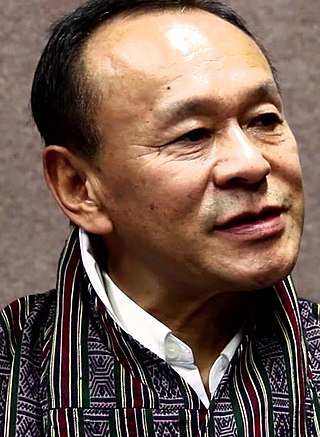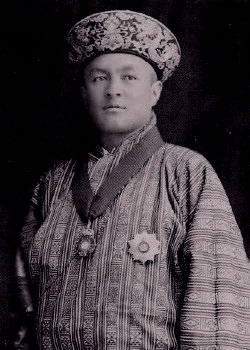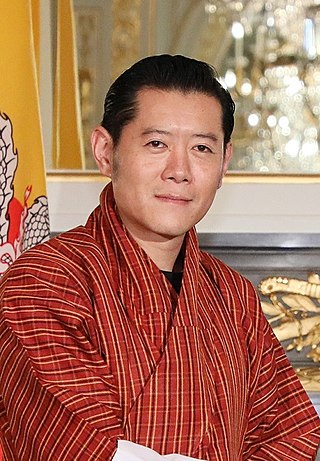| |||||
| Decades: | |||||
|---|---|---|---|---|---|
| See also: | |||||
The following lists events that happened during 2012 in Bhutan .
| |||||
| Decades: | |||||
|---|---|---|---|---|---|
| See also: | |||||
The following lists events that happened during 2012 in Bhutan .

Bhutan's early history is steeped in mythology and remains obscure. Some of the structures provide evidence that the region has been settled as early as 2000 BC. According to a legend it was ruled by a Cooch-Behar king, Sangaldip, around the 7th century BC, but not much is known prior to the introduction of Tibetan Buddhism in the 9th century, when turmoil in Tibet forced many monks to flee to Bhutan. In the 12th century, the Drukpa Kagyupa school was established and remains the dominant form of Buddhism in Bhutan today. The country's political history is intimately tied to its religious history and relations among the various monastic schools and monasteries.

Thimphu is the capital and largest city of Bhutan. It is situated in the western central part of Bhutan, and the surrounding valley is one of Bhutan's dzongkhags, the Thimphu District. The ancient capital city of Punakha was replaced by Thimphu as capital in 1955, and in 1961 Thimphu was declared as the capital of the Kingdom of Bhutan by the 3rd Druk Gyalpo Jigme Dorji Wangchuck.

Jigme Singye Wangchuck is a member of the House of Wangchuck who was the king of Bhutan from 1972 until his abdication in 2006. During his reign, he advocated the use of a Gross National Happiness index to measure the well-being of citizens rather than Gross domestic product.

Lyonpo Jigme Yoser Thinley is a Bhutanese politician who was Prime Minister of Bhutan from 20 July 1998 to 9 July 1999, 30 August 2003 to 18 August 2004 and 9 April 2008 to 28 April 2013.

Wangdue Phodrang District is a Thromde and dzongkhag (district) of central Bhutan. This is also the name of the dzong which dominates the district. The name is said to have been given by the Shabdrung Ngawang Namgyal who was searching for the best location for a dzong to prevent incursions from the south. The word "wangdue" means unification of Country, and "Phodrang" means Palace in Dzongkha.

Jigme Wangchuck was the 2nd Druk Gyalpo or king of Bhutan from 26 August 1926, until his death. He pursued legal and infrastructural reform during his reign. Bhutan continued to maintain almost complete isolation from the outside world during this period; its only foreign relations were with the British Raj in India, under which Bhutan was a protected state. He was succeeded by his son, Jigme Dorji Wangchuck.

Jigme Dorji Wangchuck was the 3rd Druk Gyalpo of Bhutan.
Articles related to Bhutan include:

Zhabdrung was a title used when referring to or addressing great lamas in Tibet, particularly those who held a hereditary lineage. In Bhutan the title almost always refers to Ngawang Namgyal (1594–1651), the founder of the Bhutanese state, or one of his successive reincarnations.

Gongsar Ugyen Wangchuck was the first Druk Gyalpo (King) of Bhutan from 1907 to 1926. In his lifetime, he made efforts to unite the fledgling country and gain the trust of the people.

Buddhism is the state religion of Bhutan. According to a 2012 report by the Pew Research Center, 74.7% of the country's population practices Buddhism.

Jigme Khesar Namgyel Wangchuck is the Druk Gyalpo, the monarch of the Kingdom of Bhutan. After his father Jigme Singye Wangchuck abdicated the throne, he became the monarch on 9 December 2006. A public coronation ceremony was held on 6 November 2008, a year that marked 100 years of monarchy in Bhutan.

Tashichho Dzong is a Buddhist monastery and fortress on the northern edge of the city of Thimphu in Bhutan, on the western bank of the Wang Chu. It has traditionally been the seat of the Druk Desi, the head of Bhutan's civil government, an office which has been combined with the kingship since the creation of the monarchy in 1907, and summer capital of the country. In old British documents, it is known as Tassisudon.
Thowadra Monastery is a cliffside Tibetan Buddhist monastery in the Tang Valley of Bumthang District, Bhutan. Thowadra means "high rock", given its location and altitude of 3,400 metres (11,200 ft).

Lhodrak Kharchu Monastery is a Buddhist Nyingmapa Monastery of Jangter Tradition based in Bumthang District Central Bhutan. The monastery overlooks Jakar Dzong and the valley of Jakar town.
Talo Monastery ༼རྟ་ལོག་དགོན་པ༽ is a Buddhist monastery located on the hills above Punakha at an elevation of 2800m. It is the most important and scared monastery in Bhutan, since it is directly connected to the mind manifestation of Zhabdrung Ngawang Namgyal. It is commonly known as Talo Geompa or Talo Sangngak Choling Monastery.
Yongla Monastery is a Nyingma Buddhist monastery in Pema Gatshel in Bhutan and is located at Yongloa on top of a mountain and is seen when one goes through the national highway linking Samdrup Jongkhar and Pema Gatshel. Although Yongla Goenpa was founded by Yongla Lam Dorji in 1736 but the monastery was originally founded by Kheydrup Jigme Kundel in the 18th century. Kheydrup Jigme Kundel was instructed by Jigme Lingpa to find a destination that resembled that of Tsari in Tibet which looked like a ritual dagger (Phurpa). This was a move to spread the teaching of Jigme Lingpa. Jigme Kuendel reportedly travelled from Tibet through Bumthang looking for the destined place until he reached the present day Yongla accompanied by Khandro Dechen Gyalmo. When he asked the Khandro if this was the place prophesied by his master, the Khandro said, ‘Yong Yong’, meaning ‘Yes, Yes’, thus the place was named Yongla. Jigme Kuendel then meditated in this place and spread his teachings and then built a meditation center at the place. A nunnery was also built at the same place due to increase in popularity of Kuendel's teaching. The Lhakhang that is seen now was built around the 1980s and a total of 16 successive Lams have served as the abbot of Yongla Gonpa.

Jetsun Pema is the Druk Gyaltsuen of Bhutan, as the wife of King Jigme Khesar Namgyel Wangchuck. She is currently the youngest queen consort in the world. She and the King have three children: Jigme Namgyel, the heir apparent to the Bhutanese throne, Jigme Ugyen, and Sonam Yangden.

Ashi Kesang Choden is the widow of King Jigme Dorji Wangchuck. She participates in royal duties of her own accord. She is the only queen grandmother in the world. In Bhutan she is called The Royal Grandmother.

Alak Jigme Thinley Lhundup or Alak Jigme Lhundup Rinpoche was a Tibetan Tulku, as well as the former speaker of the Tibetan Parliament in Exile and former Minister with the exile Tibet administration.